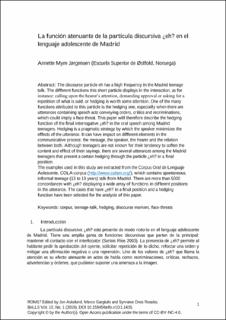| dc.contributor.author | Jørgensen, Annette Maria Myre | |
| dc.date.accessioned | 2020-02-17T10:39:26Z | |
| dc.date.available | 2020-02-17T10:39:26Z | |
| dc.date.created | 2018-02-11T20:29:54Z | |
| dc.date.issued | 2019-11-08 | |
| dc.identifier.citation | Bergen Language and Linguistics Studies (BeLLS). 2019, 10 (1). | en_US |
| dc.identifier.issn | 1892-2449 | |
| dc.description.abstract | La partícula discursiva eh está presente de modo notorio en el lenguaje adolescente de Madrid. Tiene una amplia gama de funciones en la interacción como marcador del discurso; desde llamar la atención del interlocutor, pedir aprobación y solicitar una repetición. Llama la atención su valor atenuador en solicitudes de ayuda, sugerencias u órdenes, críticas y recriminaciones. La atenuación en el español coloquial ha sido objeto de una larga trayectoria de investigación en pragmática. La atenuación es una estrategia pragmática al servicio de la comunicación mediante la que se pretende minimizar el efecto de lo dicho o lo hecho. Puede afectar a diversos elementos del proceso comunicativo: al mensaje, al hablante, al oyente o a la relación entre ambos. Si bien los adolescentes no destacan por su tendencia a atenuar hay, sin embargo, actos de habla atenuados mediante ¿eh? en posición final, realizados por los adolescentes madrileños para mitigar órdenes o críticas que pudieran implicar una amenaza a la imagen del oyente. Los casos de ¿eh? con valor de atenuante en los que se basa este estudio pertenecen al corpus oral de lenguaje adolescente, COLAm, que contiene el habla informal de adolescentes de 13 a 19 años, accesible en internet www.colam.org. En el corpus COLAm hay más de 5000 ejemplos de uso de eh con diferentes funciones y en diferentes posiciones en el enunciado. Para este trabajo se han elegido aquellos que se hallan al final de un enunciado y se consideran portadores de un valor atenuante. | en_US |
| dc.description.abstract | The discourse particle eh has a high frequency in the Madrid teenage talk. The different functions this short particle displays in the interaction, as for instance: calling upon the hearer’s attention, demanding approval or asking for a repetition of what is said, or hedging is worth some attention. One of the many functions attributed to this particle is the hedging one, especially when there are utterances containing speech acts conveying orders, critics and recriminations, which could imply a face threat. This paper will therefore describe the hedging function of the final interrogative ¿eh? in the oral speech among Madrid teenagers. Hedging is a pragmatic strategy by which the speaker minimizes the effects of the utterance. It can have impact on different elements in the communicative process: the message, the speaker, the hearer and the relation between both. Although teenagers are not known for their tendency to soften the content and effect of their sayings, there are several utterances among the Madrid teenagers that present a certain hedging through the particle ¿eh? in a final position. The examples used in this study are extracted from the Corpus Oral de Lenguaje Aolescente, COLA-corpus (http://www.colam.org/), which contains spontaneous, informal teenage (13 to 19 years) talk from Madrid. There are more than 5000 concordances with ¿eh? displaying a wide array of functions in different positions in the utterance. The cases that have ¿eh? in a final position and a hedging function have been selected for the analysis of this paper. | en_US |
| dc.language.iso | spa | en_US |
| dc.publisher | Universitetet i Bergen | en_US |
| dc.relation.uri | www.colam.org | |
| dc.subject | Korpuslingvistikk | en_US |
| dc.subject | Corpus linguistics | en_US |
| dc.subject | Diskursanalyse | en_US |
| dc.subject | Discourse analysis | en_US |
| dc.subject | corpus | en_US |
| dc.subject | teenage-talk | en_US |
| dc.subject | hedging | en_US |
| dc.subject | discourse markers | en_US |
| dc.subject | face-threats | en_US |
| dc.title | La atenuación mediante la partícula discursiva ¿eh? en el lenguaje adolescente de Madrid | en_US |
| dc.title.alternative | La función atenuante de la partícula discursiva ¿eh? en el lenguaje adolescente de Madrid | en_US |
| dc.type | Peer reviewed | en_US |
| dc.type | Journal article | en_US |
| dc.description.version | publishedVersion | en_US |
| dc.subject.nsi | VDP::Språkvitenskapelige fag: 010 | en_US |
| dc.subject.nsi | VDP::Linguistics: 010 | en_US |
| dc.source.volume | 10 | en_US |
| dc.source.journal | Bergen Language and Linguistics Studies (BeLLS) | en_US |
| dc.source.issue | 1 | en_US |
| dc.identifier.doi | 10.15845/bells.v10i1.1435 | |
| dc.identifier.cristin | 1564136 | |
| cristin.unitcode | 224,60,0,0 | |
| cristin.unitname | Avdeling for økonomi, språk og samfunnsfag | |
| cristin.ispublished | true | |
| cristin.fulltext | original | |
| cristin.qualitycode | 1 | |
